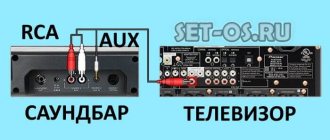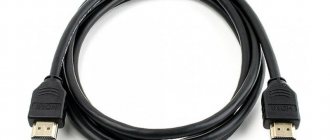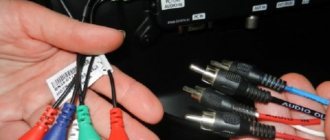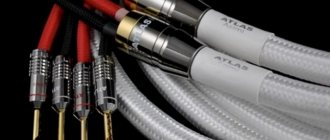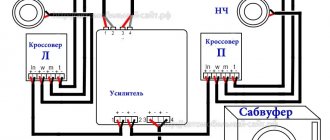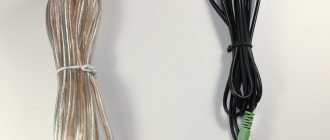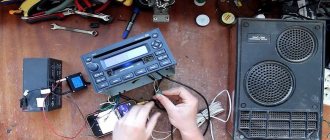Optical cable for sound when connecting to a TV - what are the advantages, principle of operation, how to choose an acoustic audio cable.
Optical Audio output
In order to work with modern technology, it becomes necessary to ensure the transfer of a large amount of information at high speed. In most cases, metal wires and cables were used for this purpose. In most cases they cope with this task, but over time their capabilities can sometimes fall short.
This problem is due to the fact that the transmission of electrical signals has important features that sometimes prevent the required operating parameters from being achieved:
- The higher the frequency used, the faster the attenuation will occur.
- When transmitting signals, energy is radiated into the surrounding space. The intensity increases with increasing frequency.
- When alternating current passes, a magnetic field arises, which induces interference on nearby wires.
Thus, when transmitting information at high speed over metal wires, there are factors that prevent further increases in efficiency. The use of fiber optic cables will allow data transmission on other physical principles.
Their work is as follows. The cable is a bundle of fibers, each of which consists of a transparent central part and a sheath. The latter not only protects the fibers from mechanical damage, but also has reflective properties.
Transmission of light through optical fiber cable:
The signal carrier is a light beam, which, while passing through the fiber, is repeatedly reflected from its walls, practically without losing its energy.
Their small diameter makes them flexible, allowing them to be laid wherever needed.
Information is encoded by modulating the light flux using a laser. When it reaches its destination, decryption is performed using a photodetector.
In this way, information transfer rates of several terabits per second can be achieved. However, such high speeds can only be achieved using very high quality optical fiber. Its use allows you to obtain the following advantages:
- High speed and significant amount of transferred data.
- High degree of protection against external interference.
- Small cross-section, which allows the cable to be laid wherever necessary.
- There is no danger of breakdown associated with the presence of high voltage.
- There is no way to secretly copy data along the signal path without damaging the fiber.
However, during the operation of digital audio out cables you will have to face the following disadvantages:
- When laying, it is impossible to make sharp bends. This may damage the cable.
- Reading and writing information via an optical audio cable requires specialized equipment.
- It is not possible to connect wires using twisting. To achieve this goal, the ends must be soldered together.
The use of optical fiber to transmit acoustic signals allows for high quality playback. This method is considered the highest quality for transmitting analog sound.
Optical connectors for transmitting sound on a TV:
When transmitting an audio signal, processing occurs in several stages:
- Initial conversion from electrical to optical.
- Transmission via fiber optic cable.
- Signal reception.
- It is converted from optical to electrical and then reproduced.
Although it is believed that it is impossible to cut and connect optical cables, in some cases this can be done manually, but the slightest mistake will dramatically reduce the transmission quality. Therefore, it is preferable to use those cables that are manufactured and prepared industrially.
Nowadays, TVs actively use the HDMI connector for connection, which ensures the transmission of high-quality images and sound.
HDMI cable
The question arises about how necessary it is to use optical fiber for sound transmission. It cannot be used in all cases. For example, if you need to separately connect a player or other sound source, then an optical cable will help to establish a high-quality connection.
Audio optical output for TV cable
What types of Digital Audio Out Optical are there?
The S/PDIF standard is used for audio transmission. It stands for "Sony/Philips Digital Interface Format". To implement it, you can use two types of cables:
- Coaxial uses RCA connectors. This option is gradually becoming a thing of the past, giving way to fiber optic cable. However, many audio devices have such connectors for connection. It can be used, but this technology will not help you get the perfect sound.
How does a coaxial cable work? - The fiber optic is called TOSLINK . It allows you to get great sound, but at the same time the connection technology remains simple. Its use is becoming more widespread.
TOSLINK is now much more commonly used with this standard, so its name and S/PDIF are usually used interchangeably.
Optical connections can be monomode or multimode. In the first case, the quality of signal transmission will be higher, since in multimode mode the rays are reflected at different angles and at large distances this can lead to a decrease in the quality of data transmission.
At the same time, single-mode cable has a higher price.
Recommendations from experts
Experts in this field recommend connecting a third-party music system using Bluetooth, since this method is simple and convenient. Bluetooth devices are distinguished by maintaining a stable channel if they are located at a short distance. Output is carried out without the help of adapters, which can provide the best sound when watching movies. In second place is the HDMI cable and other digital analogues. Thanks to an HDMI cable, you can get not only audio, but also video. The picture will be of impressive quality up to Ultra 4K.
How to choose an optical cable to connect your TV
When choosing, you should strive to ensure that the cable provides maximum sound transmission quality. In this case, you need to pay attention to the following:
- You need to purchase a cable of such length that it can be directly used for connection. It is not recommended to adjust its length yourself.
- It is believed that the cable should not be longer than 10 m , otherwise the quality of the transmitted signal may deteriorate. The optimal one is sometimes called the one that has a length of 5 m . There are types of high quality cables that provide transmissions over tens of meters while maintaining sound characteristics.
- Although a thin cable is easier to install even in difficult places, the thicker it is, the better it works and the longer it lasts .
- Any optical cable consists of fibers, each of which has its own sheath . The most expensive varieties may have an additional cable, which is made of nylon.
- It is worth paying attention to what material is used to create the transparent inner part of the fibers . The most popular are glass or silica.
Optical digital audio cable structure
Each cable is characterized by the maximum frequency of the audio signal it transmits.
It must match the characteristics of the audio system being used. Usually we are talking about a frequency of 9-11 MHz.
History and essence of technology
Optical signal transmission was a topic for science fiction writers just a few decades ago. The ability to harness the incredible speed and data density that light is capable of was a cherished goal for communications pioneers. Back in the 1840s, physicists Daniel Colladon and Jacques Babinet demonstrated the ability of light to be reflected in a stream of water, and in 1854, another physicist John Tyndall proved that the light flux can be bent along with the carrier using the example of water falling into a tank from an illuminated pipe .
In 1880, Alexander Bell patented an optical telephone system, calling it a photophone, but the telephone he had previously created turned out to be more practical. The persistence of the inventor and his inspiration for the idea of sending signals through the air was not enough to popularize the device - the atmosphere did not transmit light as reliably as wires did not transmit electricity.
In subsequent decades, optical signals were used in some special cases of communication, for example, when transmitting messages between ships. The photophone itself turned out to be an unclaimed invention until the discoveries of lasers and breakthroughs in fiber-optic technologies. The experimental model was donated by Bell to the Smithsonian Institution and has lain there on a shelf to this day.
The rapid development of fiber optic technologies occurred in the second half of the 20th century. The first communications systems used a laser as a source. But already in the 1980s, researchers developed a fiber-optic cable based on glass fibers that could transmit a regular light signal over long distances. Since that time, the technology has found practical application in telecommunication systems. Most modern standards for light transmission over fiber involve the following main stages of information transportation:
- creating an optical signal from an electrical one;
- relaying a signal over a fiber while maintaining its strength and without distortion;
- optical signal reception;
- converting it to electric.
The most commonly used transmitters are semiconductor devices (LEDs), which operate optimally in the required modulation frequency range. The receiver is a photodetector in combination with an amplifier to restore a weakened or distorted signal. The fiber optic wire itself consists of the following components:
- Core. Made from a material with an extremely low refractive index.
- Shell. Mirror coating for complete internal reflection.
One of the features of light wires is the difficulty of connecting at the cut site. Such procedures require special equipment and micron precision. Therefore, for domestic use only ready-made cables of multiple lengths are used.
How to connect speakers and audio systems to your TV via optical output
When making the connection, you must prepare a fiber optic cable of the required length in advance. It is considered sufficient if it exceeds the distance between the TV and speakers by 15 cm.
When laying, it is necessary to position the cable correctly. It must be remembered that it should not have sharp bends.
You need to find the corresponding port on the back of the television receiver. Its exact name depends on the TV model you are using. The most common names are “Optical Digital Audio Out”, “Optical Audio”, “SPDIF” or “Toslink”.
The port can be covered with a cap. To open it, you need to insert the cable with slight force. This will open the connector. After this, the cable is pushed a little more so that it becomes tight.
Next, connect to the audio system. To do this, the other end of the cable is inserted into a suitable connector.
After this, the speaker system and TV are turned on. If the sound is played normally, this means that the connection was successful. If it is missing, you need to check whether the sound volume on the speakers and the one selected on the TV are sufficient.
The cable should not be twisted or stretched, as this will lead to poor performance. If there is mechanical damage, it cannot be repaired - it will have to be replaced.
It must be taken into account that an important condition for the correct operation of the cable is cleanliness at the connection points. There shouldn't even be a speck of dust here.
Diagram for connecting audio systems via optical cable to a TV
Main connectors
Before connecting, you should first make sure that the appropriate socket is available. Modern Samsung TV receivers use many audio connectors, for example:
- Scart
- "RCA".
- "OUT" linear type.
- Jack for headphones or headset.
- HDMI.
- Optical digital audio port.
Mainly used are the headphone and AUX jacks.
When interacting via Scart or RCA, it should be taken into account that the speakers have an amplifier and they will have to be selected according to the power level. The line connector and headphones are used only if there are no other connections. This type of device does not have a built-in amplifier and is connected via a mini jack or 3.5 mm. Digital optical ports are used in all modern technical devices. For example, a home theater, the sound of which is sometimes not inferior to a real cinema. Almost all modern TVs have outputs for HDMI or an audio port.
How to connect an optical cable for TV and home theater
Using a home theater allows you to enjoy high quality image and sound. In it, all the necessary equipment is connected to the receiver, and it is connected to the TV.
The home theater includes the following components:
- Signal source. It can come from an antenna, from the Internet, from a flash drive with a recorded movie, or in some other way.
- AV receiver or amplifier.
- All elements of the system are connected using connecting cables.
- A TV is used as an image output device.
- A high-quality acoustic system that can have a different structure.
How to connect fiber optic to a TV
To connect sound in a home theater, connect the optical input of the receiver and a similar one on the TV. Audio devices are connected to the receiver using the connectors that they have. The following are examples of connection diagrams:
- It is possible to simultaneously use a coaxial cable to connect from these devices and a fiber optic cable to connect the set-top box and TV.
- There is an active converter that converts a 5.1 digital signal to a 5.1 audio signal. It has two optical inputs and three outputs on tulip audio connectors.
5.1 home theater installation
For high-quality sound, it is better to use a fiber-optic connection. If the connection is of poor quality, it will not allow you to experience the benefits of a home theater.
HDMI standard
The last type of AV connector appeared in 2002. It has increased throughput potential, which makes it possible to transmit content without loss. If “optics” and “coaxial” compete with each other, then there is no equal to this standard. Even a simple AudioQuest Pearl HDMI will do for starters.
HDMI is being improved, the next updates guarantee broadband transmission of soundtracks with a sufficient number of DTS:X and Dolby Atmos channels. It can handle many video formats (including those with Ultra HD 4K extension, various versions of HDR, additional functions eARC, HFR. The main version is recognized as version 2.0, although HDMI 2.1 is confidently popularized, becoming increasingly widespread.
